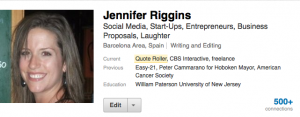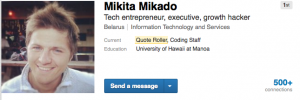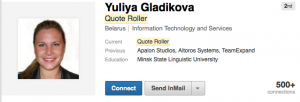How To Use LinkedIn As Your Marketing BFF
LinkedIn turned ten years old yesterday! Being American, many of my friends are on the US-based network, but are only on it because A. they were looking for a job or B. they just responded to my or someone else’s invite. Bummer, they are using it wrong! And if you’re using it the same way, you’re probably wrong, too!
Being an uber-fan and hyper LinkedIn user, I wanted to celebrate its birthday by talking about why you should be using it as your marketing BFFL (best friend for life) for both your individual and small business brands.
 Disclaimer, I’m in the top one percent of LinkedIn. I’m an addict. I think Twitter’s great for news bips, but is becoming more and more a mutual opinion admiration society. Facebook is awesome for flashes of your friends’ lives and looks, but seems increasingly negative. Pinterest, well, we’ve all wasted a couple hours looking up recipes and cute puppies in costumes. But, for your business, LinkedIn is just awesome. I have yet to find a reason** for you not to use it for your professional brand and the future of your business.
Disclaimer, I’m in the top one percent of LinkedIn. I’m an addict. I think Twitter’s great for news bips, but is becoming more and more a mutual opinion admiration society. Facebook is awesome for flashes of your friends’ lives and looks, but seems increasingly negative. Pinterest, well, we’ve all wasted a couple hours looking up recipes and cute puppies in costumes. But, for your business, LinkedIn is just awesome. I have yet to find a reason** for you not to use it for your professional brand and the future of your business.
TheNextWeb celebrated the occasion with an article called “LinkedIn is 10 years old today: Here’s the story of how it changed the way we work.” A perfect title because, for once, it wasn’t about how to use LinkedIn to look for jobs, but how it affects the way we work. I contend that LinkedIn should become apart of you and your company’s weekly, if not daily, routine.
LinkedIn as your company webpage
 If you are a freelancer or looking to expand your business, I think it’s crazy if you aren’t on LinkedIn. I believe you’ll be hard-pressed to get your business out there on the Internet faster or cheaper than via the world’s third largest social network. With it, you aren’t left worrying about how your new or old business is Googling. You’re not putting up ads. You’re not spending marketing funds on a website design. Anyone that is viewing your profile is pre-qualified as a potential business contact. I believe it’s the perfect way to connect your small business within your marketplace.
If you are a freelancer or looking to expand your business, I think it’s crazy if you aren’t on LinkedIn. I believe you’ll be hard-pressed to get your business out there on the Internet faster or cheaper than via the world’s third largest social network. With it, you aren’t left worrying about how your new or old business is Googling. You’re not putting up ads. You’re not spending marketing funds on a website design. Anyone that is viewing your profile is pre-qualified as a potential business contact. I believe it’s the perfect way to connect your small business within your marketplace.
If your company isn’t already a top Google search result, your LinkedIn page can actually act as your webpage that more people have access to view. It doesn’t work like Facebook, where your company can be an individual entity like one of your friends. Instead, on LinkedIn, you are able to present your team as a set of accomplished — and good-looking — individuals.
LinkedIn is becoming the new eLance or oDesk. As you look to build your professional LinkedIn profile — and encourage your co-workers to do the same — keep in mind that you can make sure your profiles are LinkedIn search engine optimized. Make sure you have a nice, happy, professional headshot (no one trusts those blank faces,) and make sure your professional summary and, where possible, your job title includes the key words for your company. If you are in graphic design, but your title is “art director,” don’t forget to put the words “graphic design” in your descriptions. Similarly, if you are an architect working for a big firm, but looking to do some green energy work on the side, say it! Your summary should be a narrative that describes concisely who you are, what you’ve done, and what you want to do.
LinkedIn is technically your co-worker’s personal property, but you can guide him or her to a better profile, too, by simply asking them to make sure they have a nice photo, are officially connected with your company and that they list all of their accomplishments.
LinkedIn as a CRM — Contact Relationship Manager
 LinkedIn is a great way to keep in touch in a different way and it’s maybe the best way out there to organize the broadest cast of your network. A three-hour investment upfront with another half an hour a week upkeep makes sure your LinkedIn network consistently reflects both your past and your present.
LinkedIn is a great way to keep in touch in a different way and it’s maybe the best way out there to organize the broadest cast of your network. A three-hour investment upfront with another half an hour a week upkeep makes sure your LinkedIn network consistently reflects both your past and your present.
I’d say about 15 percent of my LinkedIn and Facebook contacts overlap. Everyone else falls under the distinct professional (LinkedIn) or friendly (Facebook) branches of my networking. In TheNextWeb‘s piece, one of the founders of LinkedIn is quoted as saying, that people who have been working for at least ten years have an automatic network, but probably one that they don’t keep in touch with. And let’s face it, the old adage is true, it’s not what you know, but who you know. He calls the networks we build in our day-to-day invaluable. “I see business as a Darwinian enterprise. People tend to hire and make other business decisions by drawing on these personal networks. Is a job candidate honest or hard-working? You can’t tell from a resume or even from an interview. That’s why people fall back on trusted relationships.”
What’s great about LinkedIn is that it links together your professional world and saves it for you as you move on in life. From uni onward, you are able to keep in contact with those people who you’ve built a significant relationship with, but maybe fallen out of touch with. They’re often, but not limited to, someone who you shared a class or a cubicle with, but probably wouldn’t invite to your wedding. They would be someone you’d like to work with in the future, especially if they happen to work at an awesome company like Google or Quote Roller.
In a similar way, as a business, you could say you’ve worked with some impressive clients, but, if you’re connected via LinkedIn to folks working at those companies, you can prove it. Even better if they give you a personal reference or endorsement to prove the high quality of your work.
In another piece, I will talk to a friend who swears by his beloved LinkedIn paid-for account. I’ve never used one, partly because I’m cheap, and partly because I believe that any contact you can connect with on regular LinkedIn is a truly qualified member of your network, thus making the “free connections,” to me, better ones.
Who can you connect with? Primarily:
- people you know
- people who know people you know
- those who work or have worked at or volunteered at the same company as you
- folks with whom you share at least one group of a shared interest in common.
I cannot imagine a better way to make a first contact!
LinkedIn as your Sales Pitch
 Since you are limited with the character count when adding a connection, we not only offer you some advice here, but also some examples of what to fit into those three to four sentences you’re restricted to.
Since you are limited with the character count when adding a connection, we not only offer you some advice here, but also some examples of what to fit into those three to four sentences you’re restricted to.
Always start with “Hello/Good morning/Hola, First Name” and end with “Thanks so much/thanks for your time/have a great day, First Name.” I never use the automatic wording and I don’t think you should either. At the bare minimum, take the time to address the person you are trying to connect with!
LinkedIn is a great way to sniff out new business. It’s at least a few steps above cold calling. Contacting via freemium LinkedIn shows a more qualified lead that you can only contact if you have some sort of valued connection, like that we are member of the same professional group or we are both two degrees to Kevin Bacon. (FYI, my search result revealed 595 Kevin Bacons on LinkedIn.)
LinkedIn can be an important way to connect while you are writing a proposal. Try something like “I’m working on a thorough proposal in response to your RPF and I wanted to connect with you to learn more valuable information about X company and your needs.” Also, make sure to mention where you got the lead that inspired you to send in a proposal, whether it was a publicly advertised RPF or if you can drop names like they’re hot.
LinkedIn is also a useful way to follow up on a proposal already sent out. A simple “Just wanted to thank you again for letting (my) company send you a proposal to do X. Please let me know if have any further questions or if you are interested in a different package of our services.” Here, you show good attention to service, without seeming intrusive, while also happening to mention that you are flexible with pricing plans, without promising to lower your price.
Plus, remember, though this can be risky, if you connect with your competitors, you are one degree closer to reaching their customers, too.
You can use it to find jobs, too
In the same TheNextWeb article, they re-quote founder Allen Blue as describing the future of his company as one of the mechanisms that change the world view that instead of just needing a job, everyone can do a job that you love and are great at. LinkedIn is that facilitator to exhibit your passions and to use them to pair a perfect job for them.
Nowadays, more and more companies are moving most or all of their online recruitment to LinkedIn. Dot-coms especially are posting less on Monster.com or InfoJobs, perhaps to show camaraderie with their e-brethren or more likely because they believe in the service. Companies in general are using LinkedIn more because they really value the service and want to make sure their candidates use it. It’s also a nearly effortless way to check first-round references. LinkedIn allows companies to have more holistic views of their candidates and the types of professionals they are, while still being able to whittle down with advanced searches.
 What’s good for you is that, in these economically trying times, big job-post boards are inundated. In Spain, where I live, almost every job on InfoJobs sees 500+ applicants. It’s easier to drown than stand out in a candidate pool that crowded! When a recruiter sweeps swiftly through the applicants on most job boards, they are using search functionalities to make fast cuts. They can do that on LinkedIn too, but a two-second glance at your photo and tagline may be enough to keep you in the running. Plus, if you are in a professional group with them or are connected near to them, you are bumped up to the top of their search results.
What’s good for you is that, in these economically trying times, big job-post boards are inundated. In Spain, where I live, almost every job on InfoJobs sees 500+ applicants. It’s easier to drown than stand out in a candidate pool that crowded! When a recruiter sweeps swiftly through the applicants on most job boards, they are using search functionalities to make fast cuts. They can do that on LinkedIn too, but a two-second glance at your photo and tagline may be enough to keep you in the running. Plus, if you are in a professional group with them or are connected near to them, you are bumped up to the top of their search results.
Of course, I believe using LinkedIn to search for jobs is rather useless if that’s the only time you log in. You aren’t optimizing LinkedIn and using it as a social network, if you are only using it when you need or want a new job. This interconnected world is all about relationship building, which means putting some time and effort into cultivating new virtual relationships and doing at least the minimum (“liked” or retweeted anyone’s update lately?) to keep in touch with those you already have.
When it all comes down to it, LinkedIn is a professional social network. So get professionally social on it!
How do you use LinkedIn to grow your business?
**OK, I must admit, many of my business English students here in Spain have a solid fear. They believe if they update their LinkedIn, their bosses will think they are looking for a new job (which, really, they usually are.) Spain allegedly has the top percentage of LinkedIn sign-ups, with the lowest level of usage. They tend to only use it when they join the 27 percent of folks unemployed. This is not getting it — it’s a professional social network, not a community job board. Using LinkedIn on the regular, interacting in different groups in your field, and being a clear representative of your company will eliminate your boss’s justification to worry (while still really making you appear more qualified and hirable.)
Also, I was one of those 300,000 people whose passwords were compromised last year. Now, it didn’t turn me away from the social network, but it did remind me to stop being lazy and using the same passwords for everything.
Comments